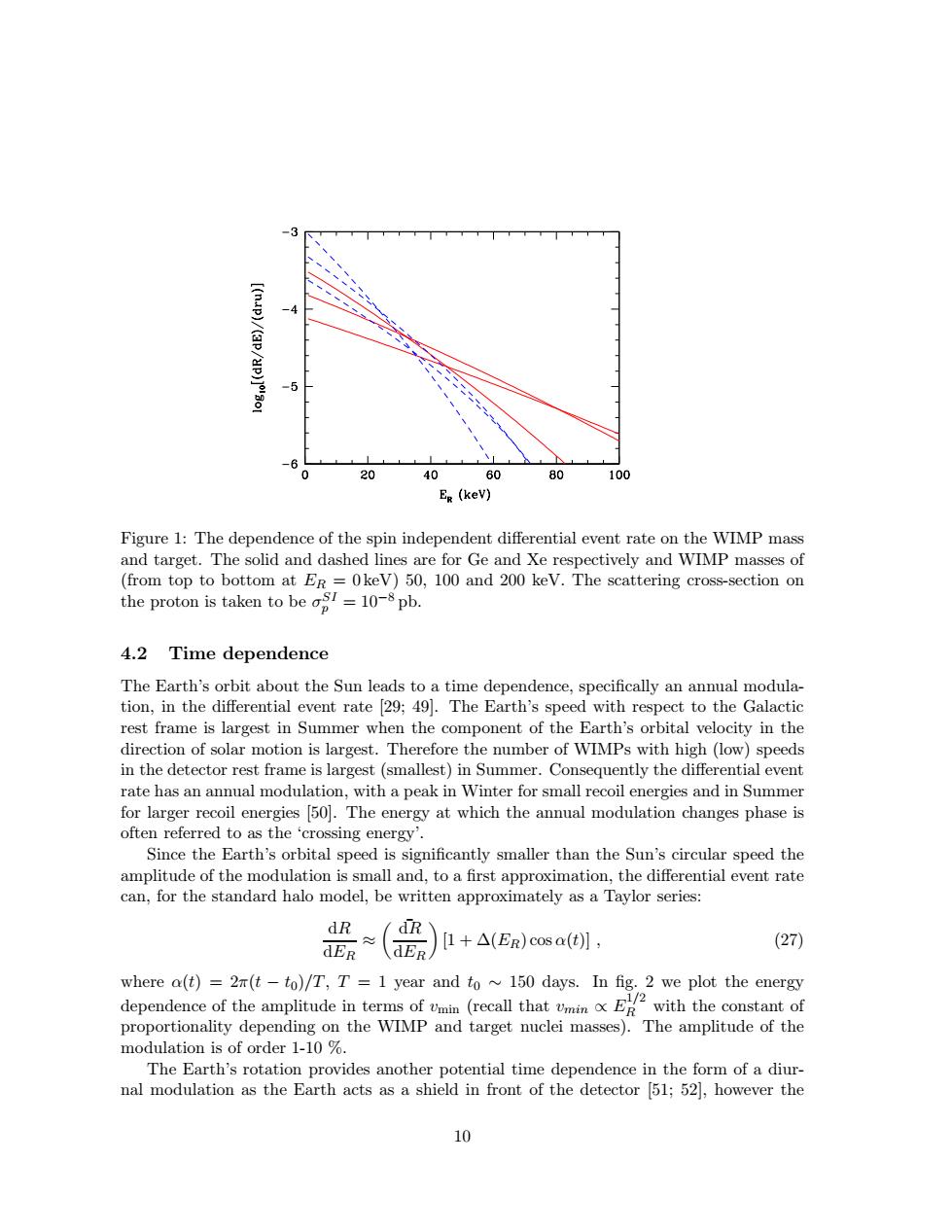正在加载图片...

-3 [(np)/(3p/ /Hp)] -5 6 1 0 20 40 60 80 100 ER(kev) Figure 1:The dependence of the spin independent differential event rate on the WIMP mass and target.The solid and dashed lines are for Ge and Xe respectively and WIMP masses of (from top to bottom at ER =Okev)50,100 and 200 keV.The scattering cross-section on the proton is taken to bes=10-8pb. 4.2 Time dependence The Earth's orbit about the Sun leads to a time dependence,specifically an annual modula- tion,in the differential event rate [29;49].The Earth's speed with respect to the Galactic rest frame is largest in Summer when the component of the Earth's orbital velocity in the direction of solar motion is largest.Therefore the number of WIMPs with high (low)speeds in the detector rest frame is largest (smallest)in Summer.Consequently the differential event rate has an annual modulation,with a peak in Winter for small recoil energies and in Summer for larger recoil energies [50].The energy at which the annual modulation changes phase is often referred to as the 'crossing energy'. Since the Earth's orbital speed is significantly smaller than the Sun's circular speed the amplitude of the modulation is small and,to a first approximation,the differential event rate can,for the standard halo model,be written approximately as a Taylor series: dR dR ≈ dER dER [1+△(Ea)cosa(t)1: (27) where a(t)=2r(t-to)/T,T =1 year and to ~150 days.In fig.2 we plot the energy dependence of the amplitude in terms of (recall thatwith the constant of proportionality depending on the WIMP and target nuclei masses).The amplitude of the modulation is of order 1-10 % The Earth's rotation provides another potential time dependence in the form of a diur- nal modulation as the Earth acts as a shield in front of the detector [51;52],however the 10Figure 1: The dependence of the spin independent differential event rate on the WIMP mass and target. The solid and dashed lines are for Ge and Xe respectively and WIMP masses of (from top to bottom at ER = 0 keV) 50, 100 and 200 keV. The scattering cross-section on the proton is taken to be σ SI p = 10−8 pb. 4.2 Time dependence The Earth’s orbit about the Sun leads to a time dependence, specifically an annual modulation, in the differential event rate [29; 49]. The Earth’s speed with respect to the Galactic rest frame is largest in Summer when the component of the Earth’s orbital velocity in the direction of solar motion is largest. Therefore the number of WIMPs with high (low) speeds in the detector rest frame is largest (smallest) in Summer. Consequently the differential event rate has an annual modulation, with a peak in Winter for small recoil energies and in Summer for larger recoil energies [50]. The energy at which the annual modulation changes phase is often referred to as the ‘crossing energy’. Since the Earth’s orbital speed is significantly smaller than the Sun’s circular speed the amplitude of the modulation is small and, to a first approximation, the differential event rate can, for the standard halo model, be written approximately as a Taylor series: dR dER ≈ ¯ dR dER [1 + ∆(ER) cos α(t)] , (27) where α(t) = 2π(t − t0)/T, T = 1 year and t0 ∼ 150 days. In fig. 2 we plot the energy dependence of the amplitude in terms of vmin (recall that vmin ∝ E 1/2 R with the constant of proportionality depending on the WIMP and target nuclei masses). The amplitude of the modulation is of order 1-10 %. The Earth’s rotation provides another potential time dependence in the form of a diurnal modulation as the Earth acts as a shield in front of the detector [51; 52], however the 10